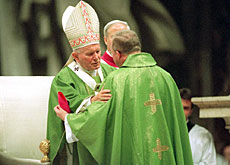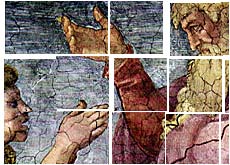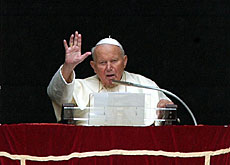Pope’s visit highlights religious rifts

The Pope’s upcoming visit has brought tensions between Catholics and Protestants, as well as the State and Church, bubbling up to the surface.
Last week’s nomination of a Swiss ambassador to the Vatican has led to claims by Protestants that the state is favouring Catholicism over other religions.
Just days before Pope John Paul II was due to arrive in Switzerland, the government said it was appointing an ambassador in an effort to “normalise” relations with the Vatican.
Until now the country’s ambassador to Prague has also had responsibility for the Vatican.
The government said that the name of the ambassador would be revealed at the beginning of the Pope’s two-day trip on June 5 and 6.
“Rocky” relationship
Although the country has maintained relations with the Holy See for over 80 years, the relationship has often been a rocky one.
Swiss-Vatican relations were particularly shaken after the Pope named the highly conservative Wolfgang Haas as Bishop of Chur in 1988. Until then the Chur diocese had nominated its bishops independently.
Haas’ combative style and conservatism alienated many people within the Church and after ten years he was moved – a rare concession on the part of the Pontiff – to the diocese of Vaduz in Liechtenstein.
Not consulted
For Switzerland’s Protestants, the announcement of an ambassador to the Vatican is unwelcome.
“We would have liked to have been consulted,” said Thomas Wipf, the president of the Federation of Swiss Protestant Churches.
Wipf says the decision to “normalise” relations is not just a pure formality, as the government claims, because the Vatican is not just a state but also a Church.
It would lead to Catholics getting preferential treatment over other religions, says Wipf.
Switzerland is more than 40 per cent Catholic and 35 per cent Protestant. While the relationship between the two main churches is normally harmonious, critics say that the Vatican has tried several times to distance itself.
One such example is inter-religious marriages in Switzerland. Although a historic accord between Swiss Catholics and Protestants in 1972 gave the green light to such marriages, Rome has raised concerns.
Another example is the recent Papal instruction, “Redemptionis Sacramentum”, which reaffirmed the exclusion of non-Catholics from the celebration of Holy Communion.
It’s for this reason that the Federation of Swiss Protestant Churches has declined an invitation to attend Mass during the Pope’s visit.
State and Church
Secular tensions are also marking the Pontiff’s visit. The influence of Protestantism and its democratic structures have profoundly marked the country.
Switzerland was home to Ulrich Zwingli and Jean Calvin – two leading figures of the Reformation that led to over half of Swiss territory abandoning Rome.
There were periodic religious wars in Switzerland but the last one, in 1847, resulted in victory for the Protestant Radicals who drew up the Swiss constitution – which still defines Switzerland – a year later.
This also meant that until the end of the 19th century, Catholic conservatives were effectively banned from federal politics. This situation only came to an end when the first Catholic entered the cabinet in 1898.
Liberal
The fact that the Protestants did not have a rigid ecclesiastical hierarchy has also influenced Swiss Catholics.
Swiss Catholics generally enjoy greater rights to participate in the daily running of the Church. This includes, among other things, the possibility of electing priests.
Following the Second Vatican Council, which took place in the 1960s, a “Synod” was established in Switzerland in the 1970s, which tried to reconcile modern thinking and Catholicism.
It also tried to give a new role to laymen and women. Only last year, pastoral councils in several cantons called for the abolition of the requirement of celibacy for priests and urged that women be admitted to the priesthood, much to the indignation of the Catholic hierarchy.
For many Swiss Protestants – and a good number of Swiss Catholics – the Pope therefore represents a Church set in its ways, which has lost sight of the real world.
The debate surrounding the Pope’s visit only serves to strengthen this impression.
swissinfo, Daniele Papacella (translation: Isobel Leybold)
Religious landscape in Switzerland:
Three million Catholics (more than 40 per cent of the population.)
Thirty-five per cent Protestants.
Four per cent Muslims.
Four per cent other religions.
More than ten per cent of the population has no religious belief.

In compliance with the JTI standards
More: SWI swissinfo.ch certified by the Journalism Trust Initiative



You can find an overview of ongoing debates with our journalists here. Please join us!
If you want to start a conversation about a topic raised in this article or want to report factual errors, email us at english@swissinfo.ch.